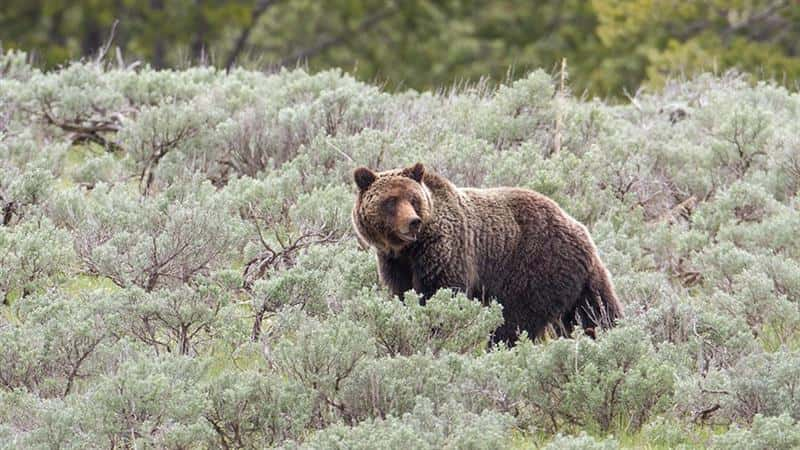Choteau, Montana rancher Karli Johnson will serve as one of the witnesses in a House Natural Resources Committee hearing on Thursday, March 23rd at 8:15 am, Mountain Time.
The hearing will cover four bills: H.R. 1419 the Comprehensive Grizzly Bear Management Act, H.R. 1245 the Grizzly Bear State Management Act, H.R. 764 the Trust the Science Act and H.R. 886 Save our Seas 2.0 Amendments Act.
Joining Johnson as a witness will be Wyoming Game Fish Director Brian Nesvik, Dr. Christopher Servheen Retired Grizzly Bear Recovery Coordinator for the U.S. Fish and Wildlife Service in Missoula, and Dr. Nathan Roberts Associate Professor, College of the Ozarks in Branson, MO.
Click here to watch the hearing
2023 is the 50th anniversary of the Endangered Species Act (ESA), and the committee will examine how the Act is being implemented and its success in recovering listed species. How to define success is one of the key questions surrounding the ESA. By all metrics available such as species population, habitat, and state management plans, etc. certain grizzly
bear populations and gray wolves may be considered as recovered and could qualify for delisting. However, serial litigation is keeping species on the list and affecting local communities and private landowners.
H.R. 1419: Comprehensive Grizzly Bear Management Act
Introduced by Montana Rep. Matt Rosendale and cosponsored by Montana Rep. Ryan Zinke and Wyoming’s Harriet Hageman, the Comprehensive Grizzly Bear Management Act, would require that no later than 180 days after enactment, the Secretary of the Interior shall issue a final rule removing the Northern Continental Divide Ecosystem (NCDE) Population of Grizzly Bears from the federal list of endangered and threatened wildlife.
In December 2021, the State of Montana petitioned the USFWS to delist grizzly bears within the NCDE. At the time the delisting petition was filed, Montana estimated the NCDE population to be at approximately 1,100 bears. According to a 2021 USFWS Report, the NCDE grizzly population had at least 2 out of the 3 population objectives to warrant delisting: (1) NCDE
grizzlies have maintained a well-distributed grizzly bear population within the NCDE; and (2) mortalities have been managed to keep an estimated probability of at least 90% that the grizzly bear population remains above 800 bears. The third objective, genetic connectivity between populations, is still being monitored by Montana and USFWS.
Since the publication of that report, the State of Montana committed in its delisting petition to provide connectivity of NCDE
bears to other populations areas. In preparation for possible delisting, the Montana Fish and Wildlife Commission approved a
population objective in 2018 that mirrored the USFWS objective of maintaining a population of over 800 bears with at least 90 percent certainty. In addition to population numbers, NCDE grizzly bears have more than doubled their range area since being listed, according to the USFWS. The NCDE grizzly range has grown from 9,500 square miles to over 26,000 square miles. For context, this means NCDE grizzlies are distributing to areas outside of the area known as the Rocky Mountain Front to prairie lands to the east, where they have not been for over a century.
H.R. 1245: Grizzly Bear State Management Act
This bill introduced by Rep. Hageman would require the Department of the Interior to reissue the final rule entitled “Endangered and Threatened Wildlife and Plants; Removing the Greater Yellowstone Ecosystem Population of Grizzly Bears from the Federal List of Endangered and Threatened Wildlife.
In 2021, the state of Wyoming petitioned the USFWS to delist the grizzly bear in the GYE, estimating its population to be 1,069 bears. This number is well above the recovery goal set by the USFWS of at least 500 grizzlies or to maintain an average of 674 bears. In addition, GYE grizzlies now occupy a land area of nearly 25,000 square miles, an area larger than the states of Connecticut, New Hampshire, and Massachusetts combined. States in the GYE region, including Wyoming and Montana, have formalized grizzly bear management plans in the event the species was delisted. The Wyoming management plan largely adheres to current USFWS population goals, prioritizes minimizing human and bear conflicts, and applies conservative management policies within areas outside of national parks.
In response to Wyoming’s petition, the USFWS announced on February 3rd of this year that a delisting in the GYE “may be warranted” and initiated a 12-month status review of the species. Without legislation from Congress, any rulemaking delisting the GYE will likely be vulnerable to litigation.


